Lawmakers Seek Investigation of Judges Who Criticized Supreme Court

© Kenny Holston/The New York Times

© Kenny Holston/The New York Times

© Amr Nabil/Associated Press

© Muhnnad Adam/Associated Press
编者按:
南方周末记者 柴会群 南方周末实习生 李佳彤 许玉珍
责任编辑:谭畅

2025年7月,山西省运城市中级人民法院再次开庭,审理被告人王鹏故意杀人案。南方周末记者 柴会群 摄
2025年7月23日,时隔21年,涉嫌杀妻的被告人王鹏再次在山西省运城市中级人民法院受审。
2003年初,王鹏的妻子、民办教师路亚丽在校内失踪。半年后,路亚丽的尸体在离学校十几公里的一口水井中被人发现,警方将王鹏锁定为犯罪嫌疑人,王鹏当时供认杀死路亚丽,并指认抛尸地点。
然而,律师介入后,王鹏翻供,声称其没有杀路亚丽,先前所作的有罪供述是迫于警方刑讯逼供编造的。经两次起诉,2004年12月,运城中院以“证据不足”为由判决王鹏无罪。运城市人民检察院曾就该判决提起抗诉,但被上级检察机关撤回。(详见南方周末2024年8月报道《“疑罪”:运城女教师被杀案二十年后再调查》)
王鹏的无罪判决,不仅让路亚丽家人和公安机关深感意外,也出乎王鹏家人及其辩护律师的预料。20年后,王鹏当年的辩护律师向警方表示,其对判决结果感到“有些惊讶”——“我当时觉得案件应该会判轻点,没想到会判无罪。”
警方重启调查后,王鹏再次被抓,两名家人也因涉嫌作伪证、妨害作证被追究刑责。
用一名办案民警的话说,路亚丽案能重启调查,是由于“赶上好时候了”。而王鹏家人没有料到,当时为帮王鹏“保命”交给律师的一张字条,21年后被警方找到,成为重新指控王鹏杀人的重要证据。
路家无法接受王鹏无罪。判决之后,路亚丽的父亲路跟满开始了长达20年的申诉,后来因病力不从心,又将此事托付给儿子,两代人接力。
临猗县公安局同样没放弃。“王鹏释放后,我局为查明真相,还被害人一个公平正义,经过大量工作,于2021年6月24日对路亚丽被杀一案重新立案侦查。”王鹏的起诉意见书中如此写道。
“这个案子是公安局自己把它弄起来的,弄了以后交给检察院。”临猗县公安局一位参与路亚丽案办理的民警告诉南方周末记者。据其介绍,在研究路亚丽案如何启动时,他们注意到,全国一些判了无罪的案件,通常是由法院或检察院启动再审程序来解决,极少由公安机关发起。
该民警称,媒体报道之后,曾有外省某市公安局到临猗,他们那有一个与路亚丽案“几乎一模一样”的案子,区别在于是由省高院判的无罪,当地公安打算重启调查,但缺乏经验,故前来“取经”。
在另一位办案人员看来,路亚丽案在法院作出无罪判决的背景下,时隔这么多年能重新启动,主要是“碰到扫黑除恶这个好时候了”。
该办案人员说,“复查”路亚丽案时,他们用了“最笨”的办法——按判决书上所列的“证据不足”理由,一一重新取证。然而并不容易,时隔多年,很多证据已无法找到,有的证人已不在人世。
据其介绍,为了获取新的证据和线索,警方想尽办法,包括在村里安排了“耳目”(线人)。曾有“耳目”提供信息称,王鹏家原本有一口水井,后来填掉了。警方怀疑井里埋有重要物证,将井挖开,但没有收获。
按上述办案人员的说法,当时考虑到王鹏家人可能已形成“攻守同盟”,难以突破,就没接触。而王鹏姐姐王萍已与前夫离婚,前夫作为外人,最有可能突破,于是重点与其接触。
王萍前夫有一次对警方提到,路亚丽失踪那天,他和王萍接到电话后,赶到路任教的王见村学校。王萍问王鹏怎么回事,王鹏说前一晚和路亚丽吵架,打了路,路跑了。这一说法与王鹏翻供时坚称的“回宿舍后没见到路亚丽”相矛盾,警方由此找到突破口。
路亚丽案重启侦查后,王萍于2024年10月因涉嫌包庇王鹏被刑拘。按一位办案人员的说法,她最初也一直不肯讲出实情。
警方随后从王鹏家人一开始聘请的当地律师程海丽供职的律所调取了卷宗,从中发现一张手写字条,共写了4条内容,其中第一条是:“王鹏和路亚丽平时经常开玩笑用被子将路亚丽捂住,这次也许出手重些,造成失手”。
程海丽告诉警方,这张字条是王萍写下给她的,想让她去看守所会见王鹏时,按照字条上写的内容诱导王鹏问话,以减轻其罪责。但程认为这样做违反律师职业道德,并没有照做,同时把字条放在了案卷里。
经笔迹鉴定,字条是由王萍所写。王萍向警方承认,当年在律所,由母亲贠小芹口述,她执笔写下那张字条。目的是让律师将上面的内容转达给王鹏,“显示出王鹏的犯罪为过失犯罪,让王鹏不被判死刑”。
字条上还写到,公安局查出路亚丽在婚前同几个男性发生过关系。王萍告诉警方,母亲当时没说为什么要这样写,不过她认为,这样写显得路亚丽有过错,对王鹏有好处。
一位办案人员告诉南方周末记者,他们好不容易才从律所调取到王鹏的案卷。公安内部有人对此持不同意见,认为让律师提供对当事人不利的证据不合适。但是不调取的话,案子“没法弄”,最后还是调取了。

与路亚丽新婚不久的王鹏。受访者供图
在承认写了那张字条后,王萍向警方写下“悔过书”,承诺会将功补过,努力说服母亲配合公安。随后,王萍被释放,经她做工作,贠小芹向警方承认,王鹏当年曾跟她说过杀了路亚丽。
据贠小芹向警方所作的笔录,路亚丽失踪当晚,她和王鹏住在了路亚丽宿舍。第二天白天,她发现王鹏“有些不太正常”,晚上,在她的逼问下,王鹏哭着对她说,路亚丽嫌他打麻将回来迟了,他想和路亚丽同床,但是路亚丽不愿意。两人争吵,路亚丽抓住王鹏的要害处,王鹏就和路亚丽打,然后王鹏用被子将路亚丽捂死了。
“我气得打了王鹏几个耳光,踢了王鹏几脚。我接着问王鹏把路亚丽弄到了哪里,王鹏说用摩托车带着扔到水井里面去了。”贠小芹向警方如此陈述。
据警方的一份“情况说明”,贠小芹在这次陈述案情时,多次情绪激动,边哭边说。
在贠小芹作这次笔录前后,身处看守所的王鹏父亲王养福
校对:吴依兰

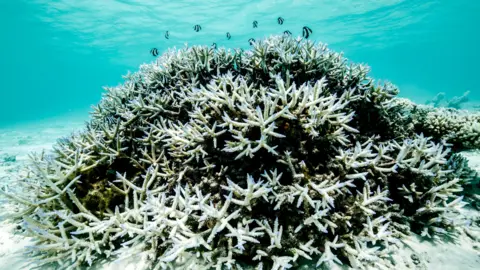 Peter Mumby
Peter MumbyThe Great Barrier Reef is headed for a "grim future" and will suffer a "rapid coral decline" by 2050 but parts may recover if global warming is kept below 2C, a new study has found.
Researchers at the University of Queensland (UQ) used modelling to simulate the lifecycles of certain coral species and found that some were better at adapting to warmer oceans and could help new coral grow.
Reefs near cooler-water currents were also more resilient, giving a "glimmer of hope" to the natural wonder, which has suffered severe climate-induced heat stress in recent years.
The study warned that curbing carbon emissions was crucial to allow coral to recover and avoid a "near collapse" of the reef.
Dr Yves-Marie Bozec, who led the research, said the modelling of more than 3,800 individual reefs that make up the Great Barrier Reef looked at their "eco-evolutionary dynamics". This included how corals interact with each other, how they deal with warmer water and corals in naturally cooler areas.
"We ran all of those factors with the most up-to-date climate projections - and the news was not good," he said.
"We forecast a rapid coral decline before the middle of this century regardless of the emissions scenario."
The Great Barrier Reef is one of the world's most biodiverse ecosystems, stretching more than 2,300km (1,400 miles) off Australia's north-east coast.
It has suffered four significant marine heatwaves between 2016 and 2022, causing much of its coral to expel the algae which gives them life and colour - a process called bleaching, which is often fatal.
A recent report found that parts of the Great Barrier Reef had suffered the largest annual decline in coral cover since records began nearly 40 years ago.
Dr Bozec said some parts of the reef "may partially recover after 2050, but only if ocean warming is sufficiently slow to allow natural adaptation to keep pace with temperature changes".
"Adaptation may keep pace if global warming does not exceed two degrees by 2100. For that to happen, more action is needed globally to reduce carbon emissions which are driving climate change."
Dr Bozec said: "The window for meaningful action is closing rapidly but it hasn't shut".
Under the Paris agreement, almost 200 nations have pledged to limit global temperature rises to 1.5C and to keep them "well below" 2C above those recorded in pre-industrial times, generally considered to mean the late 19th Century.
Prof Peter Mumby, who also worked on the study, said they found "many reefs could persist under the Paris agreement target of two degrees of warming".
"However, higher emissions leading to faster temperature rises would drive most reefs to a near collapse," he said.
Prof Murphy said reefs in areas "where the water doesn't heat up so dramatically because it is well mixed, fared better than others" and reefs close to populations of corals that can regenerate were also healthier.
Identifying areas of the reef network that are more resilient will mean efforts to protect the reef can focus on "strategic parts" of the ecosystem, he added.

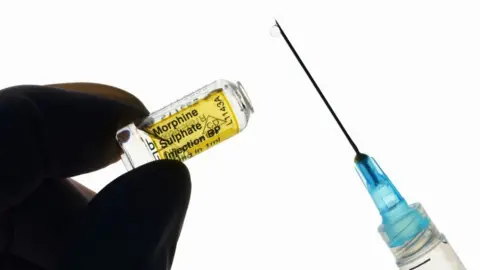 Getty Images
Getty ImagesA palliative care nurse in Germany has been sentenced to life in prison after he was convicted of the murder of 10 patients and the attempted murder of 27 others.
Prosecutors alleged that the man, who has not been publicly named, injected his mostly elderly patients with painkillers or sedatives in an effort to ease his workload during shifts overnight.
The offences were committed between December 2023 and May 2024 in a hospital in Wuerselen, in western Germany.
Investigators are reported to be looking into several other suspicious cases during his career.
According to media outlet Agence France-Presse (AFP), the unnamed man had employed at the hospital in Wuerselen since 2020, after completing training as a nursing professional in 2007.
Prosecutors told a court in Aachen that he showed "irritation" and a lack of empathy to patients who required a higher level of care, and accused him of playing "master of life and death".
The court was told that he injected patients with large doses of morphine and midazolam, a muscle relaxant, in an effort to reduce his workload during night shifts.
He was arrested in 2024.
When issuing the life sentence, the court said that the man's crimes carried a "particular severity of guilt" which should bar him from early release after 15 years.
He will be able to appeal the verdict.
Prosecutors have told AFP that exhumations are taking place to identify further potential victims, which could see the man put on trial again.
The case bears similarity to that of former nurse Niels Högel, who was handed a life sentence in 2019 after he was convicted of murdering 85 patients at two hospitals in northern Germany.
A court found that he administered lethal doses of heart medication to people in his care between 1999 and 2005.
He is believed to be the most prolific killer in Germany's modern history.

 Getty Images
Getty ImagesVoting has begun in the eastern Indian state of Bihar where more than 74 million people are eligible to vote in a crucial election that will be a precursor to several key state polls.
Voters will cast their ballots for 243 seats in a two-phase election to choose the next state government. Counting of votes is scheduled for 14 November.
The election comes after a controversial revision of electoral rolls that the opposition alleged would exclude genuine voters and give an edge to Prime Minister Narendra Modi's Bharatiya Janata Party (BJP).
The BJP and India's Election Commission have denied these allegations.
Bihar is one of India's poorest and most populous states, which sees millions migrating to other states for jobs. It is also among the few states in India where Modi's party has not managed to form a government yet on its own.
The outgoing government is an alliance between the BJP and the Janata Dal (United), or JD(U). They are contesting the elections again together while India's main opposition Congress party has tied up with the regional Rashtriya Janata Dal (RJD) and a number of smaller parties.
The election has also seen the entry of a new political party led by Prashant Kishor, a political consultant who has in the past worked with both the BJP and the Congress.
The election is also being closely watched as it might be the last to see active participation from two leaders who have shaped Bihar's politics for almost four decades - JD(U)'s Nitish Kumar and RJD's Lalu Prasad Yadav. The rivals, who are said to be in poor health, have on occasion joined hands to stay in power.

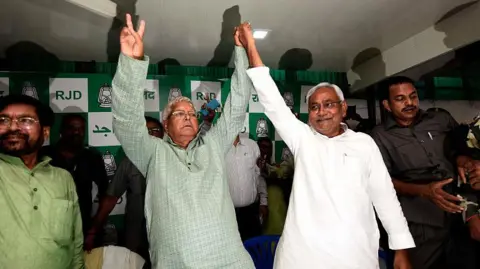 Getty Images
Getty ImagesIncumbent chief minister Kumar is one of the state's most influential leaders and has led the government for the major part of the past two decades.
He is a key ally of the BJP and played a crucial role in helping Modi's party form the federal government after the 2024 election.
RJD's Lalu Yadav served as chief minister from 1990-97. Known for his colourful personality and witty one-liners, Yadav's rise as a politician who championed marginalised caste groups transformed the political landscape of the state. His party's years in power, however, became associated with misrule and corruption. He is currently out on bail after being convicted in corruption cases.
Yadav's sons Tejashwi has been projected as the chief minister candidate for the opposition alliance.

 Getty Images
Getty ImagesThe election comes on the back of a controversial voter list revision carried out by India's Election Commission a few months ago. The commission released a list of 74.2 million voters in September, weeding out 4.7 million names.
The exercise was sharply criticised by the opposition, which accused the commission of working dropping many voters - especially Muslims - to aid Modi's party. Both the BJP and the Election Commission denied this.
Analysts say female voters are expected to play a key role in these elections - nearly half of the voters are women and their turnout has seen a steady rise.
Political analyst Santosh Singh says women in Bihar are more likely to vote over issues and that's why political parties are trying to target them with different welfare schemes. Both alliances have offered financial assistance to woo women voters.
Earlier this week, the BBC met Kushboo Devi, 40, who's been campaigning for her local candidate in Masaurhi village. She says she has been trying to get everyone to come out and vote but her focus is on women.
"Because in Bihar, wherever you see a higher voting percentage, it's usually the women who are showing up at the poll booths."
The death toll from flooding caused by one of the strongest typhoons this year in the central Philippines has risen to at least 114, authorities said on Thursday.
Typhoon Kalmaegi has flooded entire towns on Cebu, the region's most populous island, where 71 deaths were reported. Another 127 are missing and 82 injured, officials said.
Cebu provincial authorities reported an additional 28 deaths, which were not included in the tally released by the national civil defence office, according to AFP news agency.
Kalmaegi left the Philippines on Thursday morning and is currently moving toward central Vietnam, where residents are still reeling from floods that have already killed dozens of people.
Most of the deaths were due to drowning, reports said. The storm sent torrents of muddy water down hillsides and into towns and cities.
Damage to Cebu's residential areas was extensive, with many small buildings swept away and a thick carpet of mud left by the retreating floodwaters.
Local officials described the havoc wrought by the storm as "unprecedented".
Residents returning to their destroyed homes are reeling from the deadly floods earlier this week.
Jel-an Moira Servas, a business owner who lives in Mandaue city, told the BBC that she found herself waist-deep in water within minutes when her house became flooded. She quickly evacuated with her family, bringing only light items like food and electronics.
"Right now, the rain has completely stopped and the sun is out, but our houses are still filled with mud, and everything inside is in shambles," she said. "We don't even know where to start cleaning. I can't even look at it without crying."

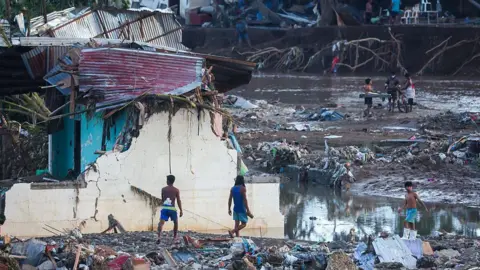 Getty Images
Getty ImagesThe national disaster agency said more than 400,000 people had been displaced by the disaster in Cebu, home to 2.5 million people.
The official death toll also includes six crew members of a military helicopter that crashed on Mindanao island, south of Cebu, after it was deployed to assist in relief efforts on Tuesday.
Carlos Jose Lañas, a volunteer rescuer, told the BBC that despite preparing for the worst case, they were caught off-guard by the extent of the flooding.
"This is the worst flood I've ever experienced," the 19-year-old said. "Almost all the rivers here in Cebu overflowed. Even emergency responders did not expect this kind of scenario."
"The rescue operation was too overwhelming for the emergency responders around Cebu, because there were a lot of people asking for help."
Typhoon Kalmaegi, locally called Tino, is the 20th tropical cyclone this year to hit the Philippines, a country prone to powerful storms.
It comes barely a month after back-to-back typhoons killed over a dozen people and wrought damage to infrastructure and crops.
Super Typhoon Ragasa, known locally as Nando, struck in late September, followed swiftly by Typhoon Bualoi, known locally as Opong.
In the months before, an extraordinarily wet monsoon season caused widespread flooding, sparking anger and protests over unfinished and sub-standard flood control systems that have been blamed on corruption.
Typhoon Kalmaegi left the Philippines at 00:30 local time (16:30pm GMT) on Thursday morning.
It has since strengthened, with maximum sustained winds increasing from 150 km/h to 155 km/h.
It is expected to make landfall in central Vietnam on Friday morning, according to forecasts. More than 50 flights there have been cancelled or rescheduled.
Vietnam has already been battling with a week of flooding and record rains that burst riverbanks and flooded some of the country's most popular tourist spots.
Thailand is also bracing for the storm's impact, with local officials warning of possible flash floods, landslides and river overflows caused by Kalmaegi.
中国国务院副总理丁薛祥说,中国愿同巴西筑牢政治互信,共同反对单边主义、保护主义和霸权主义,同时加强减贫合作,造福两国和世界各国人民。
据新华社报道,丁薛祥于当地时间星期三(11月5日)在贝伦与巴西总统卢拉会面时说,中国愿同巴西拓展各领域务实合作,推动合作持续提质升级,取得更多标志性、示范性成果;强化多边协调协作,推动全球治理改革完善,维护广大发展中国家利益;要加强减贫合作,落实全球发展倡议,更好造福两国和世界各国人民。
他还说,中国支持巴西积极发挥地区大国作用,维护拉美和加勒比地区和平稳定;赞赏巴西为举办贝伦气候峰会以及推进全球气候治理所作努力,愿同巴西一道,推动峰会取得积极成果,为气候领域多边进程注入新动力。
此外,丁薛祥也于当天与巴西总统府首席部长科斯塔会面。丁薛祥说,中国始终从战略高度和长远角度看待和发展中巴关系,愿同巴西成为各自现代化道路上值得信赖的伙伴;强化发展战略对接,高效务实推进重点领域合作,更好支持两国共同发展振兴。
丁薛祥当天也出席了在贝伦举行的第30届联合国气候大会。东道国巴西在会上提出计划,将气候融资规模提升至每年1.3万亿美元(1.7万亿新元)。
据路透社报道,由于英国表示不会为保护世界雨林的永续热带森林基金提供资金,巴西总统卢拉分别与欧盟委员会主席冯德莱恩、芬兰总统斯图布以及中国国务院副总理丁薛祥会面,请求他们为基金提供支持。

© Tasos Katopodis/Getty Images

© Maansi Srivastava for The New York Times

© Federico Rios for The New York Times

© Xu Hui/VCG, via Getty Images
知情人士透露,柬埔寨将成为首批在中国储存黄金的国家之一,这标志着北京在推动自身发展为全球黄金中心方面取得了初步进展。
彭博社引述知情人士说,柬埔寨计划将部分黄金储备存放在位于深圳保税区、并在上海黄金交易所注册的金库中。知情人士还说,其他一些国家也对此表达兴趣,正评估将黄金储备从伦敦等传统黄金中心分散配置的好处。
北京希望成为其他国家黄金的托管方,因为它正寻求建立一个对美元和西方金融中心依赖度更低的全球金融体系。知情人士透露,北京与柬埔寨的协议涉及存放新购入的金条,而不是从现有储备中转移金属。
各国央行负责管理储备资产。柬埔寨央行行长上个月说,正在考虑“几个地点”作为柬埔寨黄金的存放地,但她没透露中国是否是其中之一。
根据世界黄金协会的最新评估,柬埔寨央行持有约54吨黄金,占柬埔寨260亿美元(339.45亿新元)外汇储备的四分之一。
中国与柬埔寨有着长期的友好关系。
欧盟再就补贴问题对中国企业开展调查后,欧盟中国商会对此表达关切,并指中企在相关调查中遭遇歧视性对待,同时呼吁开放与合作才是构建互利共赢中欧经贸关系的正确途径,而非猜疑与排斥。
据中新社报道,总部位于布鲁塞尔的欧盟中国商会星期三(11月5日)发表声明称,欧盟当天根据《外国补贴条例》,宣布对参与竞标葡萄牙里斯本轻轨项目的中车唐山机车车辆有限公司所谓补贴问题展开调查。欧盟中国商会对此深表关切和反对。
声明称,欧盟《外国补贴条例》赋予欧方审查非欧盟企业过度自由裁量权,“实际执行存在极大不确定性,给非欧盟企业尤其是中国企业带来沉重合规负担”。
声明还说,欧盟中国商会持续收到中企反馈,显示在多起与欧盟《外国补贴条例》有关的调查中,中企遭遇不成比例、歧视性和不透明对待。这类做法可能向国际投资者发出负面信号,损害欧盟秉持的开放、公平和非歧视原则。
声明敦促欧盟以真正客观、公平和非歧视方式执行《外国补贴条例》,确保条例不会沦为保护主义或排除企业参与采购的单边工具。
欧盟中国商会还说,当前中企已展现强大竞争力、合规意识以及对欧洲可持续发展的承诺,开放与合作才是构建互利共赢中欧经贸关系的正确途径,而非猜疑与排斥。
《外国补贴条例》自2023年7月生效,欧盟目前已针对中国发起多次调查,行业涉及太阳能、风力涡轮机和电动车等,均为中国新能源相关领域。
美国总统特朗普星期三(11月5日)称,他可能会与中国和俄罗斯合作制定一项无核化的计划,但没有透露具体细节。
据路透社报道,特朗普在迈阿密举行的美国商业论坛上说:“我们重建了核力量,我们是世界第一大核武国家,我很不愿意承认这一点,因为这太可怕了。”
特朗普说:“俄罗斯排在第二。中国远远落后,排在第三,但他们四五年内就会赶上我们……我们三国或许会制定一项无核化计划。看看能否奏效。”
特朗普上星期四(10月30日)在韩国与中国国家主席习近平会晤前几个小时在社交媒体发文说:“由于其他国家的核试验计划,我已指示美国战争部在平等的基础上,开始测试我们的核武器。这个工作将立即开始。”
由于中国与俄罗斯目前都没有进行此类武器试验,目前尚不清楚他所指何国。不过,俄罗斯总统普京上星期三(29日)宣布,已成功测试核动力无人潜航器“海神”(Poseidon)。

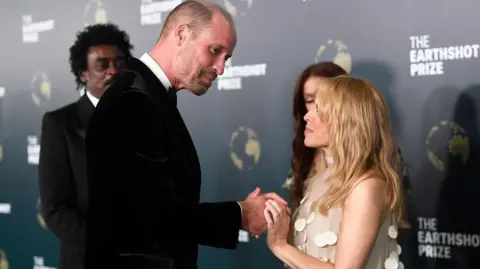 AFP via Getty Images
AFP via Getty ImagesThe Prince of Wales has revealed the five winners of this year's environmental Earthshot Prize, calling them an "inspiration that gives us courage".
Prince William said their work was "proof that progress is possible" during Wednesday evening's awards ceremony in Rio de Janeiro's Museum of Tomorrow.
Winners include a project for making South America's Atlantic Forest financially viable and a global ocean treaty initiative aimed at conserving marine life.
Brazilian football legend Cafu, Olympic gymnast Rebeca Andrade and former Formula 1 driver Sebastian Vettel were among the award presenters.
Performances from Kylie Minogue, Shawn Mendes and Brazilian queen of pop Anitta also got the jubilant mood swinging.
Earthshot Prize supports eco-friendly projects from around the world, and annually awards each of the five winners with a £1m grant to scale up their ideas aimed at repairing the world's climate.
Organisers of the initiative were inspired by former US President John F Kennedy's Moonshot project, which challenged scientists to get astronauts to the Moon and back safely.
Hosted by award-winning Brazilian broadcaster Luciano Huck, the awards ceremony was addressed by Prince William, the Earthshot Prize's president.
"When I founded the Earthshot Prize in 2020, we had a 10-year goal: to make this the decade in which we transformed our world for the better," he told attendees.
"We set out to tackle environmental issues head on and make real, lasting changes that would protect life on Earth."
There are five Earthshots or goals: Protect and Restore Nature; Clean Our Air; Revive Our Oceans; Build a Waste-free World; and Fix Our Climate.
The future king has committed himself to it for 10 years, with Rio marking a halfway point for the venture.
This year saw nearly 2,500 nominees submitted from 72 countries. Out of them, 15 finalists were selected, from which the five winners were chosen.
Referring to the winners as "innovators", Prince William called the Earthshot Prize a "mission driven by the kind of extraordinary optimism we have felt here tonight".
"There's a great deal we can learn from their determination, their vision for scale, and their unyielding belief that we can create a better world."
The chair of the board of trustees, Christiana Figueres, said they were building a "global legacy".
"These winners are proof that the spirit of collective action born here in Rio continues to grow stronger, more determined, and more urgent than ever.
"Their 2030 aims are deeply ambitious - but their impact to date, their plans in place and their tenacity fuels my optimism."
Earlier in the day, Prince William met the 15 finalists during a visit to the Christ the Redeemer statue, where he posed for a photograph on the same spot his late mother, Diana, Princess of Wales, did 34 years ago.
But much of the prince's five-day visit to Brazil has been focused on climate and the environment.
On Tuesday, he criticised criminals for their involvment in the deforestation of the Amazon rainforest during a speech at the United for Wildlife conference.
He also travelled to the small island of Paqueta, where he met locals, learnt about mangrove conservation and planted tree saplings.
On Thursday, he will be travelling to Belem in the Amazon rainforest, where he is scheduled to give a speech at COP30, the UN's annual climate change meeting.

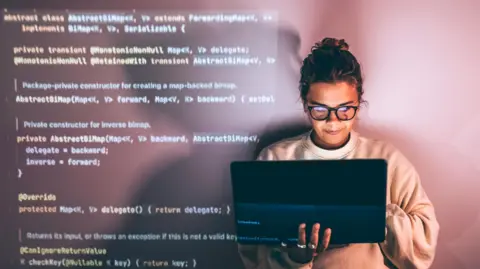 Getty Images
Getty ImagesIf you've ever wanted to create your own computer program but never learnt how to code, you might try "vibe coding".
Collins Dictionary's word of the year - which is confusingly made up of two words - is the art of making an app or website by describing it to artificial intelligence (AI) rather than by writing programming code manually.
The term was coined in February by OpenAI co-founder Andrej Karpathy, who came up with the name to represent how AI can let some programmers "forget that the code even exists" and "give in to the vibes" while making a computer program.
It was one of 10 words on a shortlist to reflect the mood, language and preoccupations of 2025.
By giving an AI tool a simple description such as "make me a program that schedules my weekly meals", people can use "vibe coding" to make basic apps without any previous programming knowledge.
More complicated tools still require skill, but the practice has opened up creating digital platforms to non-coders.
As many have discovered, it isn't perfect - with no guarantee the code will actually work or be free of bugs.
Alex Beecroft, the Managing Director of Collins, said the term "perfectly captures how language is evolving alongside technology".
Not all the words necessarily first emerged in 2025 - but Collins decided this was the year they became popular.
For example "clanker", a term used to describe robots in Star Wars games and movies since the mid 2000s, made the list after it went viral on TikTok in July as people shared their frustrations with AI-powered machines.
While "aura farming" - people doing things for the sake of looking cool, often when they know they're being filmed - was first used in January 2024, but became increasingly popular over the course of 2025.
And the portmanteau "broligarchy" took off in 2024 to describe the owners of the world's biggest technology companies and their purported political influence - and was used frequently in 2025 following the appearance of many of the bosses at US President Donald Trump's inauguration.
The other definitions in the shortlist were:


Sign up for our Tech Decoded newsletter to follow the world's top tech stories and trends. Outside the UK? Sign up here.

 Getty Images
Getty ImagesHeadaches are something almost all of us deal with at some point.
They can last from a couple of minutes to days and the pain can be sharp, dull, throbbing or stabbing and sometimes spread beyond your head to your scalp, face or even your neck.
Dr Xand van Tulleken, who hosts the BBC's What's Up Docs wellness podcast, knows the feeling all too well and says he gets headaches once a month or every six weeks and it "feels like someone's drilling into my eyeball".
While it's easy to panic about what might be behind a bad headache, Dr Katy Munro, a GP and expert at the National Migraine Centre, says it's rarely something serious.
"It's natural to worry that something is seriously wrong, but the chances of that are actually very small," she explains.
She advises that if it's your "first or worst headache, get it checked out by a doctor," but if you're getting a pattern of milder, recurring headaches, there are a few simple things you can try at home as well as seeing your GP.
Dr Xand says understanding your own headaches can be surprisingly helpful as they often don't have a single cause so keeping a diary can help you spot patterns and triggers.
For some people, weather such as thunder and lightning could trigger it, while for others it might be sensitivity to light.
"The worst time for me is when we're driving in the autumn and the sun is low and the sun is flickering through the trees...it really aggravates," says Dr Munro.
It's worth noting down things like:
But, Dr Munro cautions that you shouldn't overdo it.
"I made the mistake of making mine very detailed, which was depressing. Instead keep it simple and maybe write a number from one to 10 to summarise the impact it had on your day.
"It's also useful to track how many crystal-clear days you have, not just the bad ones.
Your doctor can then review it to help identify patterns.
You might think that caffeine is something you should instantly avoid if you have a headache but Dr Munro says the truth is more nuanced.
In small, careful doses, it can make painkillers more effective if you are not having too much caffeine on a daily basis.
"Caffeine is a co-analgesic which means it can boost the effect of a painkiller," Dr Munro explains, but avoid it in the afternoon and evening as it can disrupt your sleep.
It's worth also thinking about your caffeine consumption more broadly - consuming lots of it every day can cause a caffeine overuse headache and if you suddenly stop, you might get a withdrawal headache.
What you eat and when may make a difference if you're suffering from headaches.
Dr Munro recommends following a diet similar to the Mediterranean one that is rich in protein, healthy fats and complex carbs which can help stabilise your energy levels.
You should avoid quick-release sugary snacks and definitely don't skip meals as that can be a common trigger.
Dr Munro says she found her headaches were helped by cutting out dairy and gluten, though that's not universal.
"I also found eating regularly and taking lunch to work made a difference," she says.
As well as thinking about food, Dr Munro says regular exercise, good sleep, stress management and staying hydrated can also help reduce headaches.
You should drink enough during the day so your pee is a pale clear colour and you don't feel thirsty.
"There are lots of things, like painkillers or anti-nausea tablets, you can buy over the counter that may be helpful to manage headaches" says Dr Munro.
She cautions that you should avoid "anything containing codeine" as it can make some headaches occur more frequently and can worsen symptoms like nausea.
"Painkillers can work extremely well but it does depend on how severe your headache is.
"If they're becoming more frequent or intense, your GP can help you find a more suitable medication."
Make sure you don't regularly take painkillers on more than two days a week as this will reduce your risk of rebound headaches.



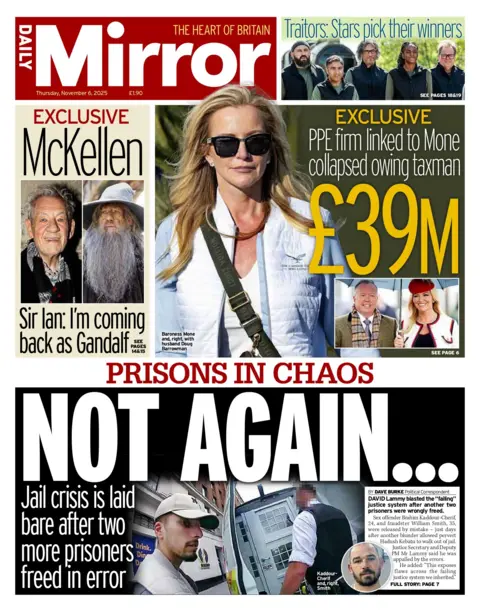







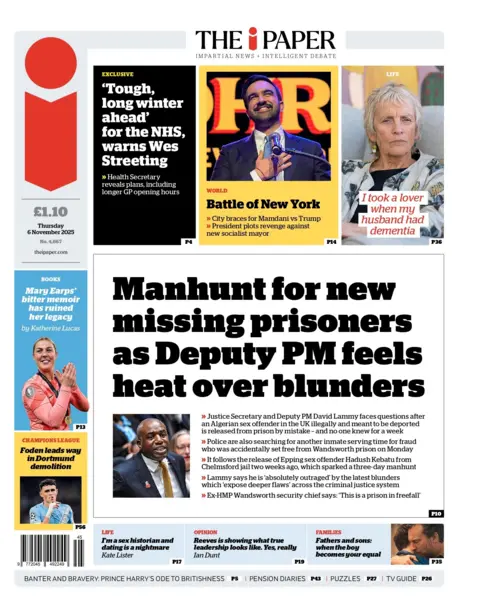

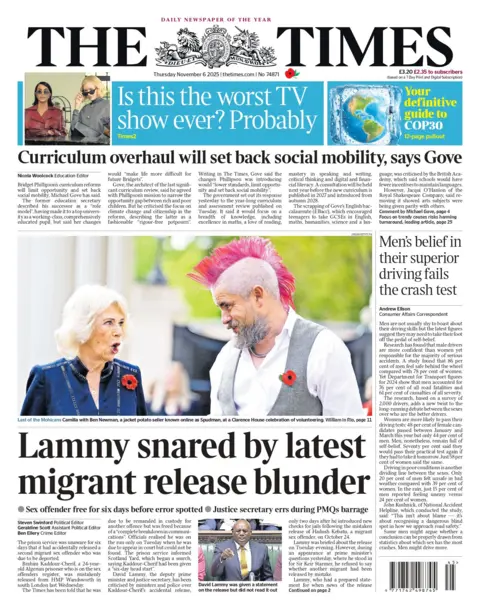

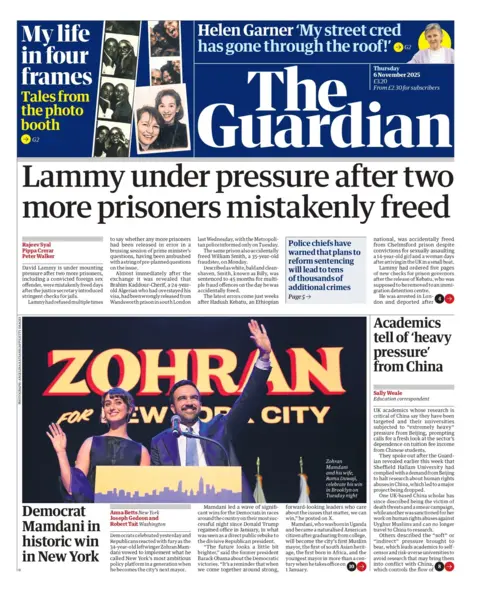

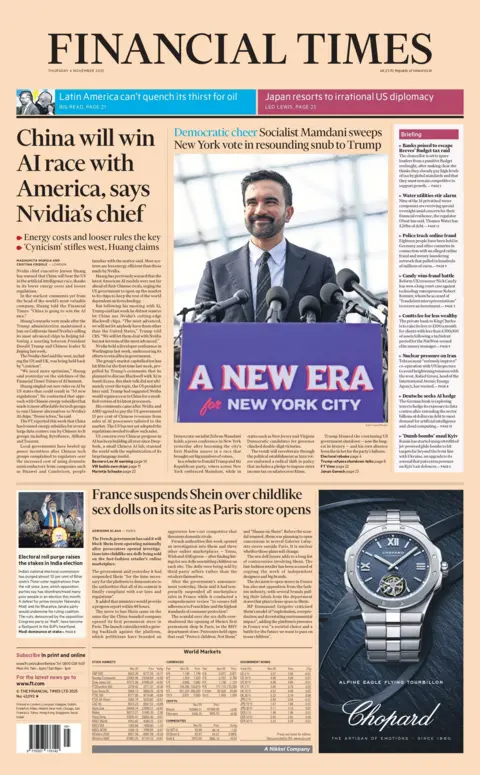

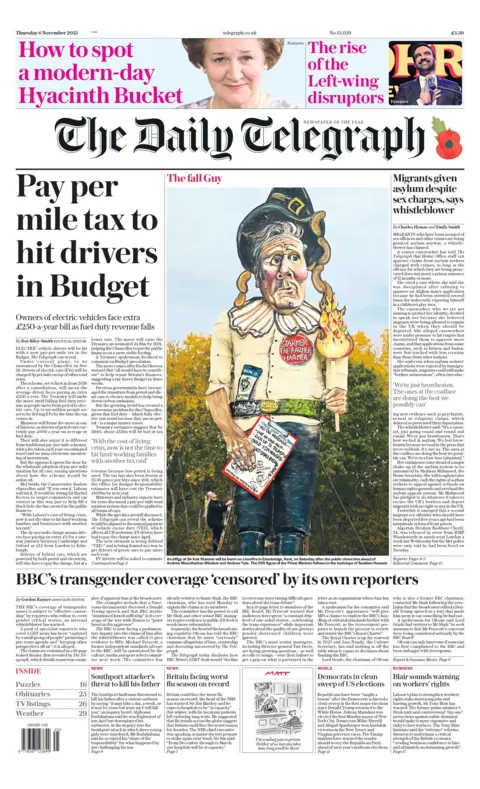






Sign up for our morning newsletter and get BBC News in your inbox.



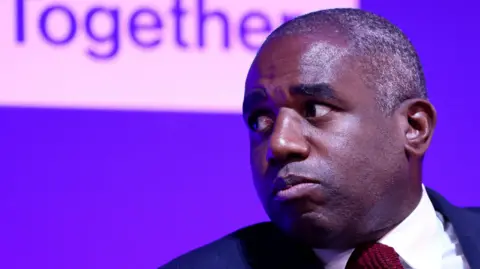 Reuters
ReutersIt is always perilous for a government when it clearly lacks grip on an issue voters would reasonably expect it to be in control of.
The stand out example of this in recent years has been the arrival of migrants on small boats.
From Rishi Sunak's promise to "stop the boats" to Sir Keir Starmer's promise to "smash the gangs" both have been found wanting and the problem remains huge.
Now the government confronts another example: a justice system that is palpably, transparently and repeatedly failing – and where measures designed to address the issue of letting prisoners out by accident aren't working.
According to government figures published in July, 262 prisoners were released in error in the year to March of this year - a 128% increase on 115 in the previous 12 months.
In other words, it has been a problem for some time, and it is getting worse.
And, context is everything in politics: this row now comes after the mistaken release of perhaps the most high-profile prisoner jailed this year.
Hadush Kebatu, who arrived in the UK on a small boat, was jailed after sexually assaulting a 14-year-old girl and a woman while living in an asylum hotel in Epping in Essex, only to be let out by accident. He has since been deported.
It gave the issue of accidental releases from prison a salience and prominence it hadn't had until then.
Once again, we are seeing ministers use the language we usually see from opposition politicians.
The Home Secretary Shabana Mahmood has described the number of people arriving on small boats as "shameful".
Now, the Deputy Prime Minister and Justice Secretary David Lammy is saying he is "absolutely outraged" over the mistaken release a week ago of Brahim Kaddour-Cherif, a 24-year-old Algerian sex offender.
Lammy added that his officials have been "working through the night to take him back to prison."
Which brings us to the messy genesis of this saga, at B-Team Prime Minister's Question Time on Wednesday lunchtime.
With the prime minister at the COP climate summit in Brazil, it was his deputy who was answering questions.
The Conservatives put up the shadow defence secretary James Cartlidge, who repeated a question, using a very particular form of words, over and over again.
He wanted to know if an "asylum-seeking offender had been accidentally released from prison".
It was obvious from the Press Gallery that Cartlidge was on to something – because of the apparent precision of his language and his constant repetition of the question.
But Lammy chose to repeatedly duck the question, despite, we later learnt, knowing about the case Cartlidge was referring to.
So why didn't he address it?
It turns out Cartlidge had got his facts wrong - Kaddour-Cherif isn't an asylum seeker. He arrived here legally but then stayed after his visa expired.
And, I understand, Lammy wasn't certain on entering the chamber whether he was an asylum seeker or not.
So setting out what he knew might also have exposed what he didn't.
His team insist "it is incredibly important to know the facts" and they argue it was for the police in the first instance to do that publicly.
Really? It seems reasonable to ask both whether Lammy could or should have known more when he arrived in the chamber and whether he could or should have disclosed more when he was there.
The Conservatives later called for him to return to the Commons to set out what he knew. The former Tory leader Sir Iain Duncan Smith suggested he may have misled the Commons. The Liberal Democrats and Reform have been very critical too.
Some also suggest Lammy's manner – shouting "get a grip, man!" at Cartlidge, among other things – was a mistake.
Could he instead have chosen to set out what he did and didn't know about the case at the beginning of the exchanges, before he took any questions?
But it is the bigger picture here that really matters: the justice system is currently repeatedly failing in that most basic of its tasks – who should be in prison and who shouldn't.
The reasons for that are complex – with difficult questions for the courts, individual prisons, the Prison Service, the Ministry of Justice and the Home Office.
It is not a new problem, but it is a growing one, and one the government doesn't have a grip on. And that, if you are the justice secretary, is a problem.

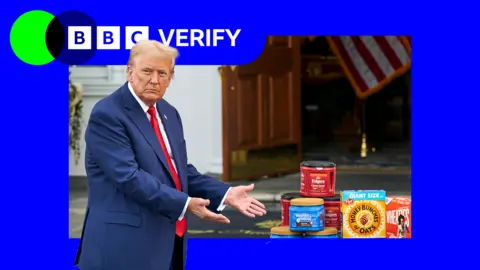 Getty Images
Getty ImagesPresident Donald Trump was swept to power for a second time on the back of a central campaign promise to tackle inflation.
The steep rise in the cost of living was top of voters' minds and Trump blamed President Joe Biden.
He also made sweeping promises to bring down prices for Americans "starting on day one".
One year on from his victory, BBC Verify revisits some of the president's claims.
"When I win, I will immediately bring prices down, starting on Day One," Trump declared at an August 2024 news conference surrounded by packaged foods, milk, meats and eggs.
Official data - which includes a four-month period when Biden was still president - shows grocery prices rose by 2.7% in the 12 months to September 2025, with some items seeing significantly sharper increases:
Since Trump took office in January, the data also shows that apart from one recorded fall in April, grocery prices have risen each month.
"The president of the United States has very little control over the price of food, especially in the short term," food economics expert Professor David Ortega told BBC Verify.
Trump's tariffs are driving up prices of certain foods, he said - a third of coffee consumed in the US comes from Brazil and therefore has a 50% tariff.
Trump's illegal immigration crackdown may also have had an impact, Ortega adds, especially in farming where as many as 40% of workers are estimated to be undocumented, which is close to a million people.
"As you know, farmers and companies have to raise wages in order to attract more labour. But trying to quantify those impacts in terms of price increase is almost impossible at the moment."
Diane Swonk, the chief economist for KPMG, believes tariff and immigration policy changes have contributed to higher costs.
"There's no question that those shifts are now starting to show up as inflation pressures," she said.
But she adds that other factors, including weather events, have contributed.
"On coffee you had climate issues for a very bad growing season and that was exacerbated by a tariff on Brazil and also Colombia," she said.

 Getty Images
Getty ImagesA White House official told BBC Verify President Trump did not control weather patterns in South America and coffee prices hikes were a global phenomenon.
Data that tracks the cost of coffee shows prices have risen globally, peaking in February, but are now falling.
The same official said the president was addressing rising beef prices by temporarily increasing imports.
While grocery prices are up overall, not every item has become more expensive.
When Trump succeeded Biden in January, the price of a dozen large eggs was $4.93 (£3.79), rising to a record high of $6.23 (£4.78) in March following bird flu outbreaks.
Since then prices have fallen to $3.49 (£2.68) a dozen.
"President Trump's supply-side policies are taming Joe Biden's inflation crisis," White House Spokesman Kush Desai said.
Other items that have fallen in price over the past 12 months include: butter and margarine (-2%), ice cream (-0.7%) and frozen vegetables (-0.7%).
During his campaign, Trump pledged to cut electricity bills sharply.
"Under my administration we will be slashing energy and electricity prices by half within 12 months, at a maximum 18 months," he told a rally in August 2024.
Since he became president, prices have risen.
The latest figures show average residential electricity rates reached 17.62 cents per kWh (kilowatt hour) in August 2025 - up from 15.94 cents per kWh in January 2025, according to the US Energy Information Administration.


"It was technically impossible [to halve prices] at the time he made the promise," according to Professor James Sweeney from the Stanford Precourt Institute for Energy.
Electricity prices not only reflect the cost of generation but also the expense of delivering it through "the wires and the transformers and everything else", he explained.
Prof Sweeney attributes the increase to both demand and supply issues.
"We have a surge in demand mostly driven by data centres. People creating images using artificial intelligence are using significant amounts of electricity."

 Getty Images
Getty ImagesHe added that cuts to renewable energy subsidies and tariffs on imported steel - which raise the cost of building new power generators - have also pushed up prices.
Swonk agreed that the AI boom is pushing up prices, especially for those on lower incomes.
"It exacerbates inequality because consumers that have more access to solar panels and renewables tend to be wealthier households," she said.
In response a White House official said that Trump was expanding coal, natural gas and nuclear power, which was "the only viable way to meet the growing energy demand and to lower energy prices".
At a campaign rally in September 2024, Trump extended his grocery pledge to cars, telling supporters: "We're going to get the prices down… groceries, cars, everything".
However, the average price of a new car topped $50,000 (£38,411) for the first time ever in September, up from $48,283 (£37,092) in January according to Kelley Blue Book, a US vehicle valuation research company.


Car prices typically rise 2-3% a year, explained Erin Keating from Cox Automotive.
"Tariffs, which have been the biggest factor in the automotive industry over the last 12 months, have been nothing but inflationary."
She explained new car prices are increasing by about 4% a year, with tariffs contributing at least one percentage point.
"We really think in 2026 that's going to go higher because most of the manufacturers are holding their fire on raising prices directly due to tariffs, but they're going to have to come in at some point."
Keating did point to tax breaks for people in Trump's spending bill, which she believes may incentivise people to buy new cars.
When asked about the rising price of cars, a White House official told BBC Verify the administration had taken historic regulatory actions to "reverse the left's radical energy scam and save billions annually".

 Getty Images
Getty ImagesTrump made a specific campaign pledge of "getting gasoline below $2 a gallon".
On the day he entered the White House the average price for a gallon of "regular" gas was $3.125 (£2.33) according to the American Automobile Association (AAA).
While a long way short of his pledge to get prices below $2, the price of a gallon of gas has fallen to a national average of $3.079 (£2.36).
In response, a White House official pointed us to a gas price comparison website, which had a slightly lower national average of $2.97 (£2.38) per gallon compared with the AAA's data.
The official added that President Trump has quickly unleashed American energy to make gas affordable again for families across the country.





© Scott Baker for The New York Times
From an embankment overlooking Gaza City, there's no hiding what this war has done.
The Gaza of maps and memories is gone, replaced by a monochrome landscape of rubble stretching flat and still for 180 degrees, from Beit Hanoun on one side to Gaza City on the other.
Beyond the distant shapes of buildings still standing inside Gaza City, there's almost nothing left to orient you here, or identify the neighbourhoods that once held tens of thousands of people.
This was one of the first areas Israeli ground troops entered in the early weeks of the war. Since then they have been back multiple times, as Hamas regrouped around its strongholds in the area.
Israel does not allow news organisations to report independently from Gaza. Today it took a group of journalists, including the BBC, into the area of the Strip occupied by Israeli forces.
The brief visit was highly controlled and offered no access to Palestinians, or other areas of Gaza.
Military censorship laws in Israel mean that military personnel were shown our material before publication. The BBC maintained editorial control of this report at all times.

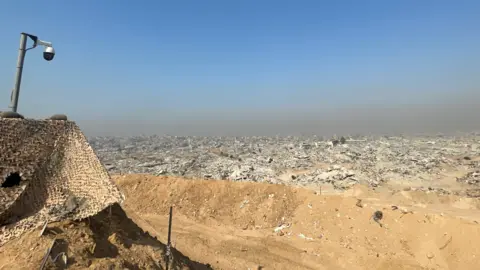
Asked about the level of destruction in the area we visited, Israeli military spokesman Nadav Shoshani said it was "not a goal".
"The goal is to combat terrorists. Almost every house had a tunnel shaft or was booby-trapped or had an RPG [rocket-propelled grenade] or sniper station," he said.
"If you're driving fast, within a minute you can be inside of a living room of an Israeli grandmother or child. That's what happened on October 7."
More than 1,100 people were killed in the Hamas attacks on Israel on 7 October 2023, and 251 others taken hostage.
Since then, more than 68,000 Gazans have been killed, according to the Hamas-run Health Ministry there.
The bodies of several hostages had been found in this area, Lt Col Shoshani said, including that of Itay Chen, returned to Israel by Hamas this week. Searches are continuing for the missing bodies of another seven hostages.
The Israeli military base we travelled to is a few hundred metres from the yellow line – the temporary boundary set out in US President Donald Trump's peace plan, which divides the areas of Gaza still controlled by Israeli forces from the areas controlled by Hamas.
Israel's army has been gradually marking out the yellow line with blocks on the ground, as a warning to both Hamas fighters and civilians.
There are no demarcations along this part of the line yet - a soldier points it out to me, taking bearings from a small patch of sand between the grey crumbs of demolished buildings.

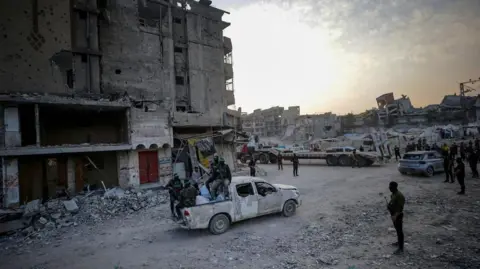 EPA
EPAThe ceasefire is almost a month old, but Israeli forces say they are still fighting Hamas gunmen along the yellow line "almost every day". The piles of bronze-coloured bullet casings mark the firing points on the embankments facing Gaza City.
Hamas has accused Israel of violating the ceasefire "hundreds of times", and Gaza's Hamas-run Health Ministry says more than 240 people have been killed as a result.
Col Shoshani said that Israeli forces were committed to the US-led peace plan, but that they would also make sure that Hamas no longer posed a threat to Israeli civilians, and would stay as long as necessary.
"It's very clear to everyone that Hamas is armed and trying to control Gaza," he said. "This is something that will be worked out, but we're far from that."

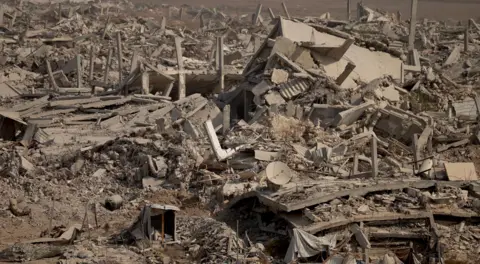 Moose Campbell/ BBC
Moose Campbell/ BBCThe next stage of the US-led plan requires Hamas to disarm and hand over power to a Palestinian committee overseen by international figures including President Trump.
But rather than give up its power and weapons, Col Shoshani said, Hamas was doing the opposite.
"Hamas is trying to arm itself, trying to assert dominance, assert control over Gaza," he told me. "It's killing people in broad daylight, to terrorise civilians and make sure they understand who is boss in Gaza. We hope this agreement is enough pressure to make sure Hamas disarms."
Israeli forces showed us a map of the tunnels they said that soldiers had found beneath the rubble we saw – "a vast network of tunnels, almost like spider's web" they said – some already destroyed, some still intact, and some they were still searching for.
What happens in the next stage of this peace deal is unclear.
The agreement has left Gaza in a tense limbo. Washington knows how fragile the situation is - the ceasefire has faltered twice already.
The US is pushing hard to move on from this volatile stand-off to a more durable peace. It has sent a draft resolution to UN Security Council members, seen by the BBC, which outlines a two-year mandate for an international stabilisation force to take over Gaza's security and disarm Hamas.
But details of this next stage of the deal are thin: it's not clear which countries would send troops to secure Gaza ahead of Hamas disarmament, when Israel's troops will withdraw, or how the members of Gaza's new technocratic administration will be appointed.
President Trump has outlined his vision of Gaza as a futuristic Middle Eastern hub, built with foreign investment. It's a far cry from where Gaza is today.
Largely destroyed by Israel, and seen as an investment by Trump, the question is not just who can stop the fighting, but how much say Gazans will have in the future of their communities and lands.

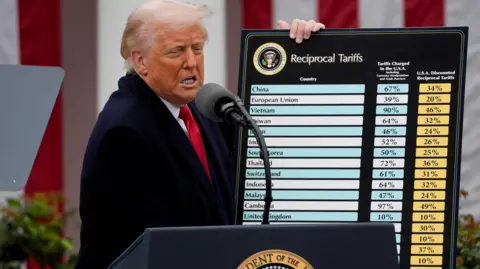 KENT NISHIMURA/POOL/EPA-EFE/REX/Shutterstock
KENT NISHIMURA/POOL/EPA-EFE/REX/ShutterstockDonald Trump's sweeping use of tariffs in the first nine months of his second term was sharply questioned during oral arguments before the Supreme Court on Wednesday.
Chief Justice John Roberts, and justices Amy Coney Barrett and Neil Gorsuch – three conservative jurists considered swing votes in this case - peppered US Solicitor General John Sauer, representing the president's administration, during his more than 45 minutes before the court.
They were joined by the court's three liberal justices, who also expressed scepticism about whether federal law – and the US Constitution – give the president authority to unilaterally set tariff levels on foreign imports.
"The justification is being used for power to impose tariffs on any product from any country in any amount, for any length of time," Roberts said.
If the court ruled for Trump in this case, Gorsuch wondered: "What would prohibit Congress from just abdicating all responsibility to regulate foreign commerce?"
He added that he was "struggling" to find a reason to buy Sauer's arguments.
The case centres around a 1977 law, the International Emergency Economic Powers Act (IEEPA), that Trump's lawyers have said gives the president the power to impose tariffs. Although the Constitution specifically vests Congress with tariff authority, Trump has claimed that the legislature delegated "emergency" authority to him to bypass longer, established processes.
Sauer asserted that the nation faced unique crises – ones that were "country-killing and not sustainable" - that necessitated emergency action by the president. He warned that if Trump's tariff powers were ruled illegal, it would expose the US to "ruthless trade retaliation" and lead to "ruinous economic and national security consequences.
Trump first invoked IEEPA in February to tax goods from China, Mexico and Canada, saying drug trafficking from those countries constituted an emergency.
He deployed it again in April, ordering levies from 10% to 50% on goods from almost every country in the world. This time, he said the US trade deficit - where the US imports more than it exports - posed an "extraordinary and unusual threat".
Those tariffs took hold in fits and starts this summer while the US pushed countries to strike "deals".
Lawyers for the challenging states and private groups have contended that while the IEEPA gave the president power to regulate trade, it made no mention of the word "tariffs"
Neil Katyal, making the case for the private businesses, said it was "implausible" that Congress "handed the president the power to overhaul the entire tariff system and the American economy in the process, allowing him to set and reset tariffs on any and every product from any and every country, at any and all times."
He also challenged whether the issues cited by the White House, especially the trade deficit, represent the kind of emergencies the law envisioned.
Suppose America faced the threat of war from a "very powerful enemy", Samuel Alito - another conservative justice – asked. "Could a president under this provision impose a tariff to stave off war?"
Katyal said that a president could impose an embargo or a quota, but a revenue-raising tariff was a step too far.
For Sauer, this was a false choice. Presidents, he said, have broad powers over national security and foreign policy – powers that the challengers want to infringe on.
A key question could be whether the court determines whether Trump's tariffs are a tax.
Several justices pointed out that the power to tax – to raise revenue – is explicitly given to Congress in the Constitution.
Sauer's reply was that Trump's tariffs are a means of regulating trade and that any revenue generated is "only incidental".
Of course, Trump himself has boasted about the billions his tariffs have generated so far and how essential this new stream of funding is to the federal government.
Treasury secretary Scott Bessent, who attended the hearing, made no comment when asked by the BBC what he thought of the hearing. Secretary of Commerce Howard Lutnick, also in court, flashed a thumbs-up.
US Trade Envoy Jamieson Greer was in court, along with Minnesota Senator Amy Klobuchar, who said outside after arguments, that she was "hopeful" based on the questions asked that the court would overturn the tariffs.
"I thought they were very good questions," she said, describing tariffs as an "unconstitutional power grab" by the president.
If a majority of the Supreme Court rules in Trump's favour, it will overturn the findings of three lower courts that already ruled against the administration.
The decision, no matter how it works out, has implications for an estimated $90bn worth of import taxes already paid - roughly half the tariff revenue the US collected this year through September, according to Wells Fargo analysts.
Trump officials have warned that sum could swell to $1tn if the court takes until June to rule.
During oral arguments, Barrett grappled with the question of reimbursing such revenue, wondering if it would be a "complete mess".
Katyal responded by saying that small businesses might get refunds, but bigger companies would have to follow "administrative procedures". He admitted that it was a "very complicated thing".
In remarks on Wednesday, press secretary Karoline Leavett hinted that the administration already is looking at other ways to impose tariffs if the Supreme Court rules against them.
"The White House is always preparing for Plan B," she said. "It would be imprudent of the president's advisors not to prepare for such a situation."